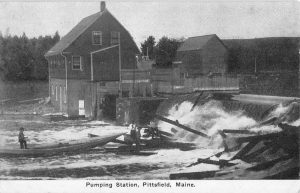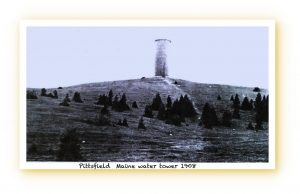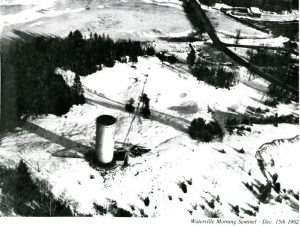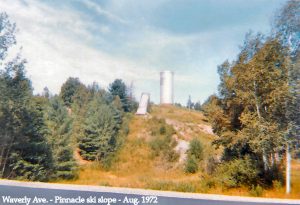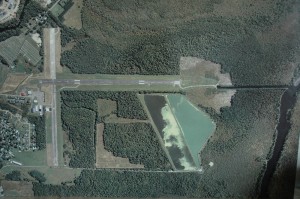Pittsfield’s Water Works
More on the history of the Pittsfield Water Works can be found on page 80 in Sanger Cook’s 1965 book Pittsfield on the Sebasticook and a 1989 Bangor Daily News story about the Pinnacle Water Tower demolition can be found on page 19 of Milestones and Memories.
Like the sewer system, the water works has been run as a self-funded Town department. The option of creating a separate water district has been discussed in the past but rejected, as the current system is working well for both ratepayers and taxpayers.
The water system is more complex than the sewer system, needing to maintain sufficient hydraulic pressure with minimal pumping cost throughout the service area. Fortunately, similar to the sewage treatment system, the Town is utilizing the least-cost groundwater source option, which minimizes treatment requirements under the Safe Drinking Water Act. Also like the sewer system, water mains are of varying sizes, materials and condition, linked closely to age. The Town has inventoried its system in detail, and this data has been translated to GIS format for querying ability. This makes system analysis much more readily accomplished. In addition, a number of studies have been conducted over the years. The Town is currently completing recommended improvements as identified by A.E. Hodsdon Engineers in 1992.
By far the most significant (and expensive) project was construction of a new water source and related investments, including purchase of a 35-acre parcel for wellhead protection, installation of a pump station and extension of the water main 1.2 miles. Another major system improvement being put into place in 1997-98 is the replacement of the 40-foot high 100,000 gallon Grove Hill standpipe with a 100-foot high, 500,000 gallon tank. This tank will be coupled with a booster pump located at the base of Grove Hill. Together these investments will guarantee adequate pressure to the hospital area which has not had sufficient water pressure to meet State regulations. The hospital and nursing homes, in order to meet insurance requirements, have had to install private booster pumps to make up for the Town system’s pressure inadequacy.
These improvements, costing $1.5 million, are being paid for by a $600,000 grant and $900,000 loan being financed over a 30-year period at 5% interest, both obtained from the U.S. Department of Agriculture’s Office of Rural Development. Some of the standpipe painting reserve is also being allocated toward replacement of the existing tank.
Sewer System.
Pittsfield’s sewer system was begun in the 1890’s, with the original system map prepared in 1895. The 1970 Comprehensive Plan utilized this information as a base map and updated it, providing a very useful sewerage map with estimated main size. At that time, the Town’s raw sewage was still entering the river directly and correcting this problem was the priority objective. The 1970 Plan included a recommended sewer improvement plan with two major interceptors designed to collect waste from each side of the river south to the railroad tracks, then from either side of a diagonal border crossing South Main Street just south of Peltoma Avenue. These interceptors would transport sanitary waste to two facultative treatment lagoons located at the end of McCarty Road. These recommendations were accomplished in 1978 and the bonds financing the project will be paid off by sewer users in the year 2005.
The majority of the current urban area is served by public sewer. A recent extension made possible with the support of Community Development Block Grant funds along outer North Main Street has opened that area up for more compact residential development.
The two 35-acre lagoons treat the effluent naturally, by aerobic bacterial action, so that by the time water reaches the outflow at the end of the second lagoon, it is clean enough to discharge into the adjoining peat of Big Meadow Bog, and secondarily into the Sebasticook River approximately 1000 feet away. There is a final effluent chamber at the outflow at which samples are taken. The chamber is set up to add chlorine prior to discharge if bacteria levels warrant it; this has been virtually unnecessary during the life of the system. This treatment system is the most cost-effective type available, with no mechanical operations and virtually no maintenance.The system is sized and licensed to handle an average of 1.5 million gallons of wastewater per day. The current actual usage averages 600,000 gallons per day, so there is considerable room for growth. Up to 2500 gallons per day of septage waste may be added to the lagoons; this is more than sufficient to handle Pittsfield’s septic system biosolids, making a land-spreading site unnecessary.
Another priority of the 1970 Plan and continuing to this day in Pittsfield and elsewhere is the separation of storm water drainage from the sanitary sewer system. The Town’s maximum sewage flows occur during and following storm events, indicating that there is a substantial amount of storm water entering the treatment system. Sources include residential and commercial roof and cellar drains, municipal and private catch basins, and infiltration through cracks in sewer pipes.
 The Town has just completed a major separation and diversion project which will remove sanitary overflows during storm events from the East Farnham Brook watershed. The Town has hired the engineering work to design the project and is planning to implementation construction in two phases. A Sewer Department reserve fund has been established, which will begin saving for the sanitary system portion of the reconstruction, targeted to occur in 2001. This scheduling allows for necessary borrowing by sewer users to dovetail in both amount and timing with the retirement of the 1978 construction bond, holding sewer rates level. The storm water diversion portion of the project is being done in 1997-98, with the Town borrowing $375,000 over 10 years at a 3.7% interest rate from a fund established through the Maine Department of Environmental Protection (DEP) and managed by the Maine Municipal Bond Bank. Due to its magnitude, this project is being financed separately from the regular capital budget.
The Town has just completed a major separation and diversion project which will remove sanitary overflows during storm events from the East Farnham Brook watershed. The Town has hired the engineering work to design the project and is planning to implementation construction in two phases. A Sewer Department reserve fund has been established, which will begin saving for the sanitary system portion of the reconstruction, targeted to occur in 2001. This scheduling allows for necessary borrowing by sewer users to dovetail in both amount and timing with the retirement of the 1978 construction bond, holding sewer rates level. The storm water diversion portion of the project is being done in 1997-98, with the Town borrowing $375,000 over 10 years at a 3.7% interest rate from a fund established through the Maine Department of Environmental Protection (DEP) and managed by the Maine Municipal Bond Bank. Due to its magnitude, this project is being financed separately from the regular capital budget.
Original version 8-Jan-07.



